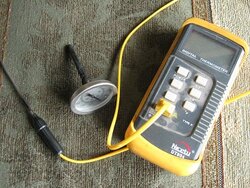I've read several places where the internal pipe temp is about twice what you see on a magnetic thermometer. Is this the case with stove top temps as well?
I've read some posts where the pipe temp is maintaining at 500 to 600. Would that be what they are reading on the thermometer or multiplying the reading by 2?
I've read where creosote can ignite at about 600 and I realize we do our best to eliminate the danger but, how much build up would there be, for it to possibly ignite?
I know a few guys who run with no thermometer at all! I think that would worry me to not actually have some idea what is going on inside temp wise.
I've read some posts where the pipe temp is maintaining at 500 to 600. Would that be what they are reading on the thermometer or multiplying the reading by 2?
I've read where creosote can ignite at about 600 and I realize we do our best to eliminate the danger but, how much build up would there be, for it to possibly ignite?
I know a few guys who run with no thermometer at all! I think that would worry me to not actually have some idea what is going on inside temp wise.


 look at the actual temperature and keep it above or below what your owners manual says.
look at the actual temperature and keep it above or below what your owners manual says.

 . In the dark that pipe would be glowing.
. In the dark that pipe would be glowing.